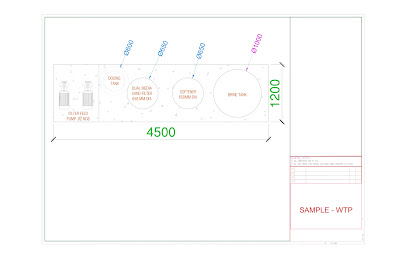💧 Water Treatment Plants (WTPs) – Overview
Water Treatment Plants (WTPs) are essential infrastructure systems designed to purify raw water from natural sources and make it safe for human consumption and distribution. These plants are commonly implemented in government, municipal, and industrial projects to ensure reliable access to clean water.
⚙️ Working Principle of WTP
The core function of a WTP is to treat raw water through a series of physical, chemical, and biological processes. The typical stages include:
1. Raw Water Intake
Water is collected from sources such as rivers, lakes, reservoirs, or borewells.
Pumping stations lift the water to the treatment facility.
2. Pre-Treatment
Large debris and particles are removed using bar screens and sedimentation tanks.
Pre-chlorination may be applied to control algae and microbial growth.
3. Coagulation and Flocculation
Chemicals like alum and polyelectrolyte are added to destabilize suspended particles.
Flocs (clusters of particles) are formed and allowed to settle.
4. Sedimentation
Flocs settle in sedimentation tanks, separating solids from clarified water.
5. Filtration
Water passes through sand or activated carbon filters to remove remaining suspended solids.
6. Disinfection
Chlorine, ozone, or UV light is used to kill bacteria, viruses, and pathogens.
7. pH Adjustment
Lime or soda ash is added to neutralize the water’s pH.
8. Fluoridation (Optional)
Fluoride is added to prevent dental decay, based on public health requirements.
9. Storage and Distribution
Treated water is stored in clear water tanks and distributed via pipelines to consumers.
Key Equipment in WTPs
Each stage of treatment involves specialized equipment:
1. Raw Water Pumps
Lift water from the source to the treatment plant.
2. Screening Equipment
Bar screens and drum screens remove large debris.
3. Sedimentation Tanks
Allow particles to settle for removal.
4. Chemical Dosing Systems
Feed pumps and dosing units add coagulants, disinfectants, and pH adjusters.
5. Filters
Sand filters and activated carbon filters remove fine particles and organic matter.
6. Disinfection Units
Chlorination systems, UV disinfection units, and ozone generators eliminate pathogens.
7. pH Adjustment Systems
Lime and soda ash dosing systems regulate water acidity.
8. Fluoridation Systems
Dosing units add fluoride as needed.
9. Clear Water Storage Tanks
Hold treated water before distribution.
10. Distribution Pumps and Pipes
Deliver water to end users through a pressurized pipeline network.
🔄 Pumps Used in WTPs
Pumps are critical for moving water and chemicals throughout the treatment process:
1. Raw Water Pumps
Centrifugal and submersible pumps lift water from the source.
2. Chemical Dosing Pumps
Diaphragm and peristaltic pumps add alum, lime, chlorine, etc.
3. Flocculation Pumps
Paddle mixers and mechanical agitators mix chemicals with water.
4. Sedimentation Pumps
Vertical turbine and submersible pumps remove settled sludge.
5. Filter Feed Pumps
Centrifugal and positive displacement pumps push water through filters.
6. Disinfection Pumps
Diaphragm and peristaltic pumps dose disinfectants.
7. Clear Water Pumps
Centrifugal and positive displacement pumps distribute treated water.
Pump selection depends on flow rate, pressure requirements, fluid characteristics, and plant capacity.
🧪 Testing and Quality Control in WTPs
Regular testing ensures that the treated water meets safety and regulatory standards:
1. Raw Water Quality Testing
Parameters: pH, turbidity, temperature, TDS, TSS, microbial and heavy metal content.
2. Process Control Testing
Monitors pH, turbidity, chlorine levels, and chemical dosing accuracy.
3. Chemical Dosing Testing
Verifies correct dosage of alum, lime, chlorine, etc.
4. Filter Performance Testing
Assesses efficiency in removing suspended solids.
5. Disinfection Testing
Ensures adequate pathogen removal and residual disinfectant levels.
6. pH Testing
Confirms treated water is within safe pH range (typically 6.5–8.5).
7. Fluoride Testing
Ensures fluoride concentration is within recommended limits.
8. Microbiological Testing
Detects bacteria, viruses, and other pathogens.
9. Distribution System Testing
Samples taken at various points to verify water quality throughout the network.
Testing frequency and scope depend on local regulations, plant capacity, and water source variability.
✅ Conclusion
Water Treatment Plants are essential for delivering safe, potable water to communities. A well-designed WTP:
Removes physical, chemical, and biological contaminants
Ensures compliance with health and environmental standards
Supports public health and sustainable development
Adapts to varying water sources and demand levels













0 Comments